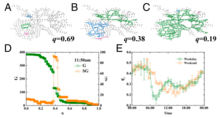Transport network
| Network science | ||||
|---|---|---|---|---|
| Network types | ||||
| Graphs | ||||
|
||||
| Models | ||||
|
||||
| ||||
A transport network, or transportation network is a realisation of a spatial network, describing a structure which permits either vehicular movement or flow of some commodity.[1][2] Examples include but are not limited to road networks, railways, air routes, pipelines, aqueducts, and power lines.
Methods[edit]
Transport network analysis is used to determine the flow of vehicles (or people) through a transport network, typically using mathematical graph theory. It may combine different modes of transport, for example, walking and car, to model multi-modal journeys. Transport network analysis falls within the field of transport engineering. Traffic has been studied extensively using statistical physics methods.[3][4][5]
Recently a real transport network of Beijing was studied using network approach and percolation theory.[6] The research showed that one can characterize the quality of traffic in a city at each time in the day using percolation threshold, see Fig. 1.
See also[edit]
- Braess' paradox
- Flow network
- Heuristic routing
- Interplanetary Transport Network
- Network science
- Percolation theory
References[edit]
- ^ Barthelemy, Marc (2010). "Spatial Networks". Physics Reports. 499 (1–3): 1–101. arXiv:1010.0302. Bibcode:2011PhR...499....1B. doi:10.1016/j.physrep.2010.11.002.
- ^ Boeing, G. (2017). "OSMnx: New Methods for Acquiring, Constructing, Analyzing, and Visualizing Complex Street Networks". Computers, Environment and Urban Systems. 65: 126–139. arXiv:1611.01890. doi:10.1016/j.compenvurbsys.2017.05.004. Retrieved 2017-08-26.
- ^ Helbing, D (2001). "Traffic and related self-driven many-particle systems". Reviews of Modern Physics. 73 (4): 1067–1141. arXiv:cond-mat/0012229. Bibcode:2001RvMP...73.1067H. doi:10.1103/RevModPhys.73.1067.
- ^ S., Kerner, Boris (2004). The Physics of Traffic : Empirical Freeway Pattern Features, Engineering Applications, and Theory. Berlin, Heidelberg: Springer Berlin Heidelberg. ISBN 9783540409861. OCLC 840291446.
- ^ Wolf, D E; Schreckenberg, M; Bachem, A (June 1996). Traffic and Granular Flow. Traffic and Granular Flow. WORLD SCIENTIFIC. p. 1. doi:10.1142/9789814531276. ISBN 9789810226350.
- ^ Li, Daqing; Fu, Bowen; Wang, Yunpeng; Lu, Guangquan; Berezin, Yehiel; Stanley, H. Eugene; Havlin, Shlomo (2015-01-20). "Percolation transition in dynamical traffic network with evolving critical bottlenecks". Proceedings of the National Academy of Sciences. 112 (3): 669–672. Bibcode:2015PNAS..112..669L. doi:10.1073/pnas.1419185112. ISSN 0027-8424. PMC 4311803. PMID 25552558.
| This article about transport is a stub. You can help Wikipedia by expanding it. |

